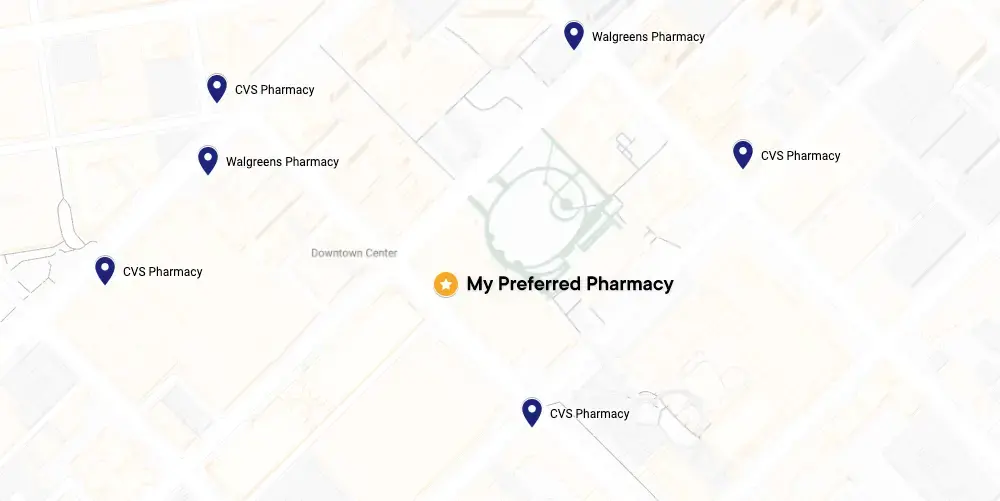
Birth control online: get a same-day prescription
Getting online birth control is more convenient than ever. Our board-certified online primary care doctors are available every day to give you the reproductive and contraceptive care you deserve - with or without health insurance. Chat with a doctor to discuss your full health history, any lifestyle or risk factors, and possible side effects to help you make the best choice for you.
We make it affordable to get same-day birth control prescriptions
We provide affordable access to same-day birth control prescriptions through convenient telehealth appointments with our qualified primary care doctors. Our board-certified doctors address a wide range of women's sexual health issues, including UTIs, yeast infections, STIs, and reproductive health concerns like PCOS and endometriosis. Whether you have insurance or not, our services offer cost-effective solutions for obtaining birth control.
Affordable or free birth control pills can be accessed through health insurance plans under the Affordable Care Act, which covers most types of birth control at no cost. For those without insurance, options like Medicaid, government programs, and over-the-counter hormonal pills like Opill are available. Additionally, free or low-cost birth control and condoms can be obtained from in-person clinics, health departments, and community programs. We ensure convenience by sending prescriptions to your chosen pharmacy or directly to you after a brief online consultation.
Types of birth control methods available online
There are many different types of prescription birth control that are available to women online. Here’s a quick overview of some of the most used methods of birth control:
Oral contraceptives (birth control pills)
Birth control shot
Birth control patch
Vaginal ring
Emergency contraception
Non-hormonal birth control option
While hormonal birth control is safer than ever, if you’re concerned about potential side effects or drug interactions, the copper IUD is a great option for an effective and convenient non-hormonal birth control. Condoms, diaphragms, spermicides, the cervical cap, and the sponge are other non-hormonal options. One newer non-hormonal birth control method is called Phexxi, which is available as a prescription vaginal gel.
Emergency contraception
Emergency contraception is oral medication that can be taken shortly after unprotected sex to reduce chances of pregnancy.
Pros and cons of popular birth control methods
|
Method |
Pros |
Cons |
|
Oral Contraceptives (Pills) |
|
|
|
IUD |
|
|
|
Implant |
|
|
|
Shot |
|
|
|
Patch |
|
|
|
Vaginal Ring |
|
|
|
Emergency Contraception |
|
|
Popular PlushCare Birth Control
How long does it take for birth control to work?
If you need your birth control to take effect right away, that’s an important concern to discuss with your doctor. Different methods vary in terms of timing.
Barrier methods like condoms work immediately, whereas a vasectomy may take three months or more. Timing for pill types depends on whether it's a combination or progestin-only pill and your menstrual cycle phase. You can start both pill types anytime, but backup methods like condoms may be needed for the first seven days.
For combination pills (COCs): If you begin within five days of your period onset, you're immediately protected from pregnancy without requiring a backup birth control method. For instance, if your period begins on a Wednesday morning, you can start the pill up to the subsequent Monday morning for immediate protection. If you start at any other point in your menstrual cycle, pregnancy protection begins after seven days of pill usage. In the first seven days of pill use, consider using an additional birth control method, such as a condom, for penis-in-vagina intercourse.
For progestin-only pills (POPs or mini-pills): Pregnancy protection starts after two days of consistent pill use, regardless of when you begin. During the initial 48 hours on the pill, be sure to use an additional form of birth control, such as a condom, if engaging in vaginal sex. It is crucial to take progestin-only pills at the same time daily. If you exceed the usual time by more than 3 hours, employ a backup birth control method for the next 48 hours.
Slynd: A newer progestin-only pill variant operates slightly differently. Immediate pregnancy protection is provided when starting Slynd within the initial five days of your period. If you’re beginning Slynd at any other point in your cycle, use an alternative birth control method (e.g., condoms) for the first seven days of penis-in-vagina sex. Unlike other progestin-only pills, Slynd does not require strict adherence to the same 3-hour window daily.
What are the side effects of stopping birth control?
Do not stop birth control without an alternative contraceptive plan unless you want to become pregnant.
Depending on which birth control method you’re using, side effects will vary.
Some common side effects after stopping hormonal birth control include irregular cycles, cramping, acne, and weight changes. It’s easier to stop pills and rings than implants.
Enhanced fertility
Although this seems obvious, many women are surprised at how quickly ovulation can resume its normal cycle. A study of women who stopped birth control3 found that over 80% of participants conceived within the first year after ending contraception.
Some women in this group became pregnant just weeks after stopping oral contraceptives. Keep in mind that you may conceive before even getting a period, since ovulation occurs 2 weeks before menses.
Typically, regular ovulation resumes within a few weeks of discontinuing most hormonal birth control methods. If you are not yet ready for pregnancy, have an alternative contraceptive plan in place.
Breast tenderness
If you already experience breast tenderness with PMS, you might notice it get worse after stopping contraception. You might also notice changes in the fullness of your breasts.
Acne
Some women begin using birth control early on to manage hormonal acne. When you stop birth control, you might notice changes to your skin. Talk to your doctor about alternative acne treatments if this is a concern for you.
Mood swings
Mood swings can increase–especially in women with a history of depression. Hormonal imbalances may lead to depression or worsen anxiety symptoms, both on and off contraception.
Blood pressure changes
Headaches
Painful menstruation
Changes in your cycle
Higher sex drive
Which types of birth control are least likely to cause weight gain?
Hormonal birth control prescriptions have improved a lot and are not likely to cause any increase in weight. Some people report minor weight gain (2–4 pounds) in the first few months of taking combination birth control pills.
However, studies show no evidence4 that birth control pills cause weight gain. Weight gain after starting birth control is usually related to fluid retention. If you're concerned about hormonal weight fluctuations, here are some options to talk about with your doctor:
Barriers
- Barrier methods5, like condoms or diaphragms, create a physical barrier to prevent sperm from fertilizing the egg.
- Being hormone-free, these methods won’t cause temporary weight gain.
- However, barrier methods are less effective than other contraceptives. Studies indicate that with typical use, 12-28 out of 100 individuals may become pregnant within a year of using barrier birth control!
Combination birth control pills
- These contain both estrogen and synthetic progestin.
- YasminⓇ, a specific brand of combination pill, utilizes drospirenone, an alternative to progestin.
- Drospirenone functions as a diuretic, reducing the likelihood of water retention and weight gain.
- When used correctly, combination birth control pills are over 99% effective.6
What's the best birth control for acne?
Physicians have long turned to birth control as a treatment for acne, especially for hormonal acne. Contraceptive pills can safely be used in combination with other acne treatments if needed.
Hormonal acne, sometimes known as "period acne," refers to breakouts that coincide with the menstrual cycle, manifesting as temporary flare-ups for some or lasting weeks for others.
This usually appears on the chin, jawline, and sometimes on the cheeks, neck, shoulders, around the mouth, and back, usually linked to fluctuating levels throughout the menstrual cycle.
Elevated androgen levels can stimulate sebum overproduction, contributing to pore blockages and acne formation. By regulating hormone levels, birth control helps reduce androgen production, decreasing sebum secretion and potentially alleviating acne concerns.
For individuals looking for birth control for acne, it's essential first to understand how it works. Not all birth control pills are equally effective in combating acne.
While some pills can be beneficial, the FDA has approved only four birth control medications specifically for treating acne: Yaz, Beyaz, Estrostep, and Ortho-Tri-Cyclen. These medications are prescribed based on their hormone composition:
- Yaz and Beyaz are the most effective due to their inclusion of drospirenone, a synthetic form of the hormone progesterone, which has anti-androgenic effects lowering testosterone levels that cause acne. Beyaz contains the same estrogen and progestin as Yaz, but also includes a type of folate in the pills.
- Ortho-Tri-Cyclen includes a different synthetic progesterone known as norgestimate. It is the second most practical option.
- Estrostep contains norethindrone and ethinyl estradiol, which are known to reduce testosterone levels. It is considered the least effective of these options in treating acne.
FAQs
How long after birth control can you get pregnant?
How long it takes to get pregnant after stopping birth control varies. If using a barrier method, you can get pregnant right away. Other methods vary depending on the type of birth control and each person’s individual response, but most women become pregnant within a year of stopping birth control.7
The British Medical Journal reports that the average length of time for a woman to become pregnant after stopping birth control varies by method, with most women returning to normal fertility after two cycles for copper IUDs and implant methods, after three cycles for oral contraceptives and vaginal rings, after four cycles for users of birth control patches, and after five to eight cycles for injectable birth control, such as the Depo shot.8
How do you clear acne after stopping birth control?
How late can I take my birth control?
When taking progestin-only pills, consistency is key - aim to take them at the same time daily. There's a three-hour window for flexibility, but effectiveness decreases if taken more than three hours late. If this occurs, ensure to use a backup birth control method, such as a condom, for the following two days. Combination pills, that contain both estrogen and progestin, are a little more forgiving, but it’s still best to try to take them around the same time each day for maximum efficacy.
Does all birth control prevent ovulation?
Do you ovulate on birth control?
How effective is birth control?
How can I get birth control online?
It is possible to get birth control online by seeing a doctor for a prescription. Our board-certified doctors can prescribe birth control after a quick visit. During an online consultation, you'll discuss your health history, lifestyle, and preferred method of contraception.
If contraception is right for you, your doctor will recommend a birth control method. If prescribed, the birth control prescription of your choice will be sent to your local pharmacy for pickup. If you are interested in the birth control implant or IUD, our physicians will refer you to a local specialist for insertion.
How can I refill my birth control prescription online?
How late can a period be on birth control?
What happens if you take birth control while pregnant?
Can I get birth control without a doctor?
Can you get pregnant while on the pill?
Does birth control make you moody?
Can you buy birth control over the counter?
Can I get birth control online without an exam?
Getting birth control online: 3 simple steps

Book a birth control appointment online.

Talk to your doctor online regarding your birth control options.

Pick up your birth control prescription.
Online birth control pricing details
30 days of free membership
- Same-day appointments 7 days a week
- Unlimited messages with your Care Team
- Prescription discount card to save up to 80%
- Exclusive discounts on lab tests
- Free memberships for your family
- Cancel anytime
Paying with insurance
Membership
$19.99
First month free
Visits
Copay
Visit price with insurance
Often the same as an office visit. Most patients with in-network insurance pay $30 or less!
We accept these insurance plans and many more:



Paying without insurance
Membership
$19.99
First month free
Visits
$129
Visit price without insurance
Sources:
PlushCare is dedicated to providing you with accurate and trustworthy health information.
- National Library of Medicine "Oral Contraceptive Pills" Accessed on February 22, 2024 at https://www.ncbi.nlm.nih.gov/books/NBK430882/#:~:text=Currently%2C%20there%20are%20three%20types,continuous%20or%20extended%20use%20pill.
- Center for Disease Control and Prevention “ Current Contraceptive Status Among Women Aged 15–49: United States, 2017–2019”, Accessed on February 22, 2024 at https://www.cdc.gov/nchs/products/databriefs/db388.htm
- National Library of Medicine “ Depo-Provera” Accessed on February 22, 2024 at https://pubmed.ncbi.nlm.nih.gov/8492647/
- National Library of Medicine “Medroxyprogesterone” Accessed on February 22, 2024 at https://www.ncbi.nlm.nih.gov/books/NBK559192/
- Center for Disease Control and Prevention “U.S. Selected Practice Recommendations for Contraceptive Use, 2013”, Accessed on February 22, 2024 at https://www.cdc.gov/mmwr/pdf/rr/rr62e0614.pdf
- Center for Disease Control and Prevention “Contraception” Accessed on February 22, 2024 at https://www.cdc.gov/reproductivehealth/contraception/index.htm
- National Library of Medicine “Contraception: Do hormonal contraceptives cause weight gain?” Accessed on February 22, 2024 at https://www.ncbi.nlm.nih.gov/books/NBK441582/
- National Library of Medicine “Extended regimen combined oral contraception: A review of evolving concepts and acceptance by women and clinicians” Accessed on February 22, 2024 at https://www.ncbi.nlm.nih.gov/pmc/articles/PMC4841029/
- The University of Arizona, “ Birth Control Prescriptions” Accessed on February 22, 2024 at https://health.arizona.edu/birth-control-prescriptions
- National Library of Medicine, “ Which birth control pills can help reduce acne?", Accessed on February 22, 2024 at https://www.ncbi.nlm.nih.gov/books/NBK279209/
PlushCare content is reviewed by MDs, PhDs, NPs, nutritionists, and other healthcare professionals. Learn more about our editorial standards and meet the medical team. The PlushCare site or any linked materials are not intended and should not be construed as medical advice, nor is the information a substitute for professional medical expertise or treatment.